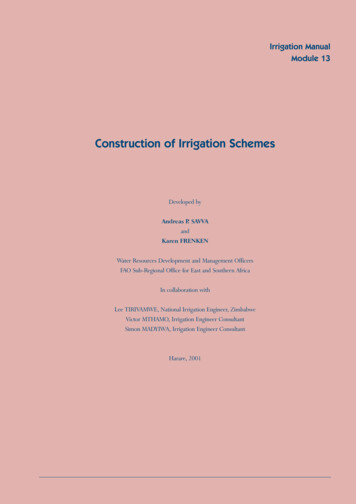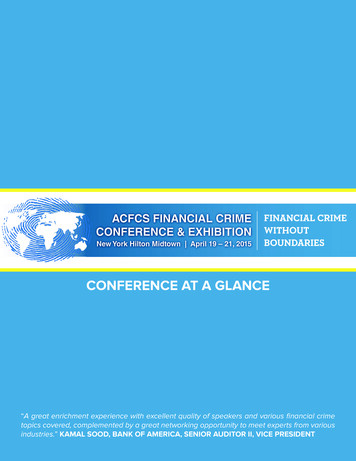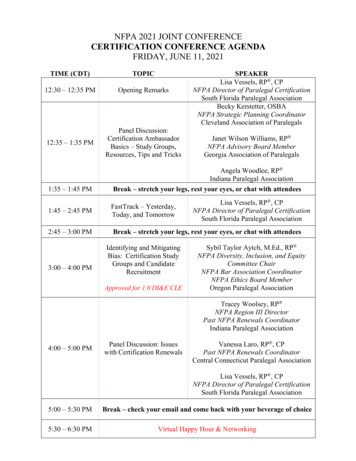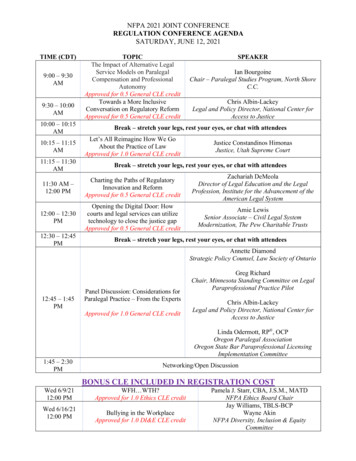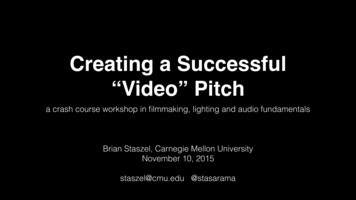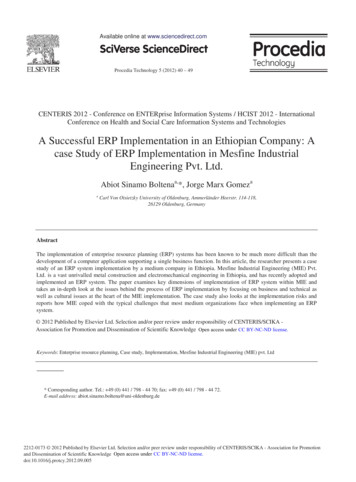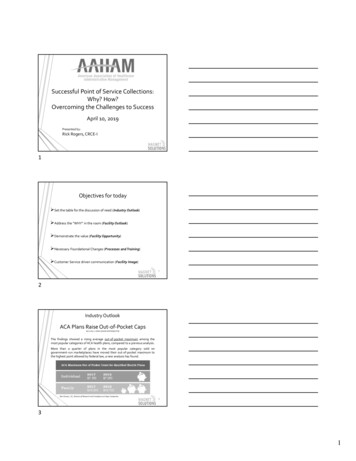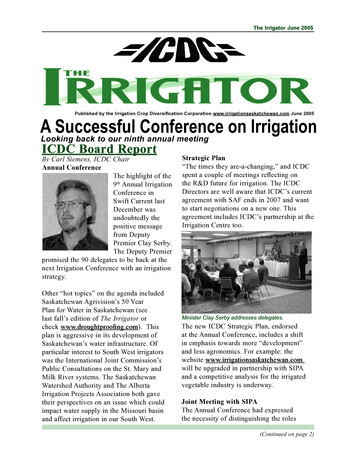
Transcription
The Irrigator June 2005Published by the Irrigation Crop Diversification Corporation www.irrigationsaskatchewan.com June 2005ASuccessfulConferenceonIrrigationLooking back to our ninth annual meetingICDC Board ReportBy Carl Siemens, ICDC ChairAnnual ConferenceThe highlight of the9th Annual IrrigationConference inSwift Current lastDecember wasundoubtedly thepositive messagefrom DeputyPremier Clay Serby.The Deputy Premierpromised the 90 delegates to be back at thenext Irrigation Conference with an irrigationstrategy.Other “hot topics” on the agenda includedSaskatchewan Agrivision’s 50 YearPlan for Water in Saskatchewan (seelast fall’s edition of The Irrigator orcheck www.droughtproofing.com). Thisplan is aggressive in its development ofSaskatchewan’s water infrastructure. Ofparticular interest to South West irrigatorswas the International Joint Commission’sPublic Consultations on the St. Mary andMilk River systems. The SaskatchewanWatershed Authority and The AlbertaIrrigation Projects Association both gavetheir perspectives on an issue which couldimpact water supply in the Missouri basinand affect irrigation in our South West.Strategic Plan“The times they are-a-changing,” and ICDCspent a couple of meetings reflecting onthe R&D future for irrigation. The ICDCDirectors are well aware that ICDC’s currentagreement with SAF ends in 2007 and wantto start negotiations on a new one. Thisagreement includes ICDC’s partnership at theIrrigation Centre too.Minister Clay Serby addresses delegates.The new ICDC Strategic Plan, endorsedat the Annual Conference, includes a shiftin emphasis towards more “development”and less agronomics. For example: thewebsite www.irrigationsaskatchewan.comwill be upgraded in partnership with SIPAand a competitive analysis for the irrigatedvegetable industry is underway.Joint Meeting with SIPAThe Annual Conference had expressedthe necessity of distinguishing the roles(Continued on page 2)1
(Board report cont’d)The Irrigator June 2005of ICDC and SIPA. ICDC is clearly theagent for R&D and SIPA is the irrigationpolicy advocate, much the same as theSaskatchewan Canola DevelopmentCommission and the Saskatchewan CanolaGrowers Association. Both ICDC andSIPA, however, have an overlapping rolein irrigation education and awareness. Bothorganizations are active in this area and thejoint meeting helped to coordinate activities.Crop Production ShowThis year’s show (it attracts over 15,000people annually) included Irrigation Alleyfor the first time. Both SIPA and ICDC haddisplays, along with irrigation companiesand others. The Irrigation Potential forSaskatchewan was featured acouple of times at the BayerCrop Science Theatre to over100 people. Identifying anIrrigation Alley led to more“serious” irrigation inquiriesfrom visitors. Next year, we’llget the centre pivot tower up forall to see (the roof wasn’t quitehigh enough).ICDC Display at EnviroForum in Swift Currentnewsletters, etc. University of Saskatchewan – WorkExperience (Co-op Students),irrigation content. Certified Crop Advisoraccreditation has been addedto ICDC seminars.ICDC has been active inthe development of Ag inthe Classroom irrigationmaterial. ICDC is workingthrough the IrrigationCentre to promote the GreenCertificate Program. ICDCICDC’s Irrigation EducationDirector John Könst is onInitiative adds CCAthe SIAST Program AdvisoryAccredited Irrigation EventsCommittee. Work by ICDCThe ICDC Board has been anon the irrigation curriculumadvocate for improved irrigationat the U of S continues. ICDC has mentorededucation opportunities in Saskatchewan. Theeight co-op students over five years from theIrrigator, July 2002, documented the existingCollege of Agriculture, working on irrigationoptions for irrigation education and training:R&D projects. School system – Project WET, Ag inthe Classroom’s Water for Life.ICDC has been involved in hosting SAF’s SIAST Moose Jaw – IrrigationDutch consultant. Hopes are for an expandedcurriculum and participation on theexchange program between students fromProgram Advisory Committee.Holland and Canada on irrigated farms. Green Certificate Farm TrainingProgram – Irrigated Crop ProductionIn 2004, ICDC added support for theTechnician course.Certified Crop Advisor Program (CCA). CCA ICDC and The Irrigation Centrehas over 14,000 certified advisors in the– extension, field days, website,U.S.A. and Canada.2
To become a CCA, one must pass twoexams, national and local. Once certified, aCCA must complete 40 hours of ContinuingEducation Units (CEUs) every two yearsin order to remain certified. Irrigation fitsthe soil and water management area ofCCA competency. ICDC offered a totalof 28 CEUs in 2004: eight for soil andwater management, three for integratedpest management, 17 for crop management.The Irrigator June 2005 Irrigation Kicks Out 500/ acre,Dryland 90 Pocket Gopher Management Package Can Irrigation Support a 10,000 HeadFeedlot in Saskatchewan? Using Irrigation to Feed a LargeDairy Haywatch SaskatchewanEFP and BMPs for IrrigatorsYeah, more acronyms! EFP stands forEnvironmental Farm Plan, and BMPfor Beneficial Management Practice.ICDC organized an EFP workshop forirrigators last winter, facilitated by DarrenSteinley. Darren is son of Howard, aSIPA Director who irrigates in the RushLake ID. Irrigators prepared EFPs, hadthem reviewed and endorsed by the peerreview committee and are now eligible forBMP funding. Irrigation BMPs includefunding of 30 percent (up to 10,000)for low pressure, low clearance sprinklersystem components, trickle componentsand backflow prevention equipment. DaveOllen (Northminster ID) and MurrayPurcell (Pike Lake), both irrigators, areon the Provincial Council of ADD Boards(PCAB), the EFP delivery agency. ICDCChair Carl Siemens is on Saskatchewan’sNational Farm Stewardship AdvisoryBoard. Irrigators are involved. Be proactive: do an EFP for your farm.CSWSEPYes, we do have irrigation funding for“infill” and expansion under the CanadaSaskatchewan Water Supply ExpansionProgram. Both ICDC and SIPA supportexpansion towards a “critical mass” ofirrigation to support value-added processing.Check the article elsewhere in The Irrigator.New ICDC Publications 2004 ICDC Demonstration ProgramFinal Report The Saskatchewan Irrigatornewsletter Crop Varieties for Irrigation 2005 Irrigation Economics andAgronomics 2005 Dry Bean Production OptionsFarmgate with Bob Simpson.Crop Insurance for TimothyICDC Agrologist Korvin Olfert “Talking Timothy” onICDC Agrologist Korvin Olfert acted asmeeting convener and data gatherer tohammer out timothy coverage levels withCrop Insurance. The program is up andrunning for 2005.3
The Irrigator June 20052005 ICDC “Value for Money R&D” projects:IRRIGATED FORAGE WORKForage CentresTimothyAlfalfa varieties (dairy)CornTOTAL2005 Budget 10,000 7,000 4,000 5,000 26,000IRRIGATED CROP VARIETY TESTINGIrrigated Crop Variety Testing (at CSIDC)Soybean Variety Testing“Bean Seed Research“Crop Disease Control“Potato Variety“TOTAL 44,000 2,500 5,000in-kind 5,000 56,500NON CROP PROJECTSCommunications (in partnership with SIPA)Audit / InsuranceNew IdeasTOTAL 5,000 2,000 5,000 12,000TOTAL 2005 Proposed Budget 94,500For more information,contact ICDC at306-867-5527Celebrating 100 years ofAgriculture in the Province:Red Fife and Marquis Wheaton Display at ICDCby Frances Thauberger, ICDC Coop Student,Swift CurrentTo mark Saskatchewan’s 100th anniversary,ICDC has included Red Fife and Marquishard red spring wheats in our demonstrationplots this year.The two varieties marked a turning pointfor North American grain production. RedFife, also known as Halychanka, arrived inCanada in 1842 when it was shipped to afarmer in Ontario named David Fife. Theshipment came via a friend in Scotland, whohad received the grain from the German portof Danzig on the Baltic Sea (now Gdansk,Poland).When David Fife planted the wheat inCanada, only one stalk ripened the firstyear. He sowed it again and in time, otherfarmers were growing it with success. RedFife had extraordinary baking qualitiesand commanded a premium price at themills. Over the course of several decades,it contributed to Canada’s reputation forgrowing high quality wheat. Eventually,researchers were able to trace the origin of4
The Irrigator June 2005the superior variety to the Eastern Europeanregion of Galicia.The only difficulty in growing Red Fife inCanada was its late maturity. At variousDominion Experimental Farms, manycrosses of Red Fife with earlier maturingvarieties were made, but most of theseresulted in lower milling and bakingqualities. In 1903, Charles Saunders andhis brother Arthur finally isolated a varietywith great potential. The cross was madeat the Experimental Farm in Agassiz, B.C.between Red Fife and Hard Red Calcuttafrom India. The cross had only earlymaturity and great baking quality, it hadsurprisingly high yield. They named itMarquis.Twenty-three pounds of Marquis wheat weresent to the Indian Head Experimental Farmin Saskatchewan for a full-scale trial in1907. Distribution began in 1909. In 1911,Seager Wheeler of Rosthern won a prize ofU.S. 1000 in gold for the best wheat grownin North America. He had harvested 250pounds from five pounds of seed on 1/19thof an acre. Many international awards forMarquis wheat followed, including one fromthe International Dry-Farming Congressfor Mr. Holmes of Raymond, Alberta and asimilar award for Paul Garlach of Allan.Marquis wheat soon became the primaryvariety grown on the Canadian Prairies andthe American mid-west and was responsiblefor a steep climb in total Canadian wheatproduction. By 1915, 80 percent of the9.8 million tons harvested in Canada wasMarquis. Before 1920, however, certainleaf and stem rust strains began to infectboth Marquis and Red Fife.Breeder and Rust Pathologist at the Semi-aridPrairie Agricultural Research Centre in SwiftCurrent. “Wheat rust is the kind of organismthat can mutate very quickly.”The major rust epidemics to Marquis wheatstimulated the development of the Cereal RustLab, which is now the Winnipeg ResearchCentre.We invite visitors to observe both Red Fifeand Marquis wheat at irrigated demonstrationplots near Osler and Baildon during ourirrigation field days this summer. Othervarieties on display at these sites includeSuperb HRSW, AC Lillian HRSW, Andrewand Meena Soft White Spring wheats, severalfeed and malt barleys, Strongfield Durum, ACMorgan and CDC Baler oats, Viking Triticale,and Bethune and Prairie Flax. We will alsodisplay Raxil and Gemini seed treatmentsin the durum and malt barley plots. We lookforward to seeing you there.2005 ICDC Field Day Schedule:Osler: Monday, July 18, 2005 - 6:30 p.m.Baildon: Tuesday, July 26, 2005 - 1:30 p.m.SPARC, Swift Current: TBAFor more information on field days, contactKorvin Olfert at 306-778-5041, or e-mailkolfert@gov.sk.cakolfert@gov.sk.c“As wheat became more common on theprairies, wheat rust became more of aproblem,” says Ron DePauw, Senior Wheat5
The Irrigator June 2005Questions about IrrigatedForage?When is the best time to cut my cereal silage?When is the best time to cut my irrigatedalfalfa?of fiber. As such, it is already useful for eitherdairy or feedlot rations. BarleyAccording to research done at theUniversity of Saskatchewan by Dr.Dave Christensen, the optimum stageto cut barley silage is at the late doughstage. Barley quality increases slightlymaturing through the dough stage. Oatsquality, in contrast, slightly decreases.This answer depends more on the specific typeBy Korvin Olfert PAg, ICDC Agrologist, of cereal rather than the animal consuming it.Swift CurrentCereal silage is grown as an energy rich sourceThe answer to this question really depends onwhat type of animal will be consuming thefeed. DairyIntensive dairy producers will belooking for alfalfa with a Relative FeedValue (RFV) of 150 or higher. To getthe quality this high, alfalfa would needto be cut about when you see the firstflower. In Saskatchewan, this meanscutting around the middle of June.Many of the dairy producers north ofSaskatoon take three cuts of irrigatedalfalfa. In order to get three good cuts,the first has to be off the field certainlyby the end of June, with second cut inthe beginning of August and third cutafter a hard frost. This type of cuttingschedule will achieve RFVs in that 150range with proteins up over 20 percent.It is possible to achieve yields of fivetons/acre of alfalfa hay (11 tons/acre ofsilage) under intensive irrigation.BeefA beef cow on maintenance overwinter will not require the same levelof quality. Taking two cuts at the moretraditional 10 percent bloom willcertainly meet the protein needs of beefcow even in late gestation. Alfalfa cutaround the 10 percent bloom will haveprotein levels closer to 15 percent.Protein levels are fairly difficult topredict in the field. They depend moreon the harvest conditions and how manyleaves are included in the bale. Thefiber content can be predicted based onthe height and stage of maturity. OatsThe optimum stage to cut oats is at theearly dough stage. Wheat, although notusually grown for silage, is intermediatebetween oats and barley. The precisefirmness of the dough is often difficultto judge and can change quite quickly.Nevertheless, when it is time to cutyour silage, cut the oat field first beforemoving on to the barley field. Rye and TriticaleRye and Triticale have awns that becomehard and indigestible. They should be cutin late flowering while the awns are stillsoft. CornCorn silage should be cut once the wholeplant has dried down to the appropriatemoisture (68 percent), whatever thestage of maturity, sufficient kerneldevelopment will have occurred to meetyour energy and yield requirements.The irrigated silage yields are similar betweenthe different cereal species (about 13 tons/acre.Corn will, however, yield 16-20 tons/acre).6
The Irrigator June 2005In the cereal variety trials last year at CSIDCin Outlook, the oats out-yielded both thebarley and triticale, although this has beendifferent in other years and other locations.In spite of similar yields, barley consistentlyhas more energy. Corn has a higher yieldpotential than any of these and more energythan even barley.In a cool year, like 2004, corn yields andquality drop to approximately that of barley.With the higher production costs of growingChopping Silagecorn, there are some years, like 2004, whereit would be better to grow barley than corn.How long should you chop silage?A lot of silage harvesters have 12 kniveson the cutting head with rollers feeding thesilage into the knives. The roller speed canbe adjusted to feed more or less silage. Afaster roller speed will result in a longerchop length. Also, the number of knives canbe adjusted. Most of the time, this theoreticalcut can be adjusted from 3/16” to 7/8”.Although 3/8” is one of the most commonsettings, the problem is that no one knowswhat theoretical cut gives the correct amountof effective fiberfor optimum milkproduction.There are anumber ofdifferent methodsof measuringeffective fiber.The most commonis the Penn StateForage ParticleSeparator. This isa set of three (orfour) black boxeswith different sizedholes. The top boxhas 3/4” (19mm)holes, and thesecond has 5/16”(8mm) holes. Byplacing the silageon the top and shaking 40 times(10 times ineach direction) this separates the silage intothe three boxes. The top one contains thecont’d on page 107
The Irrigator June 2005Canada-Saskatchewan Irrigation Diversification Centre (CSIDC)Theme: “Wealth from Water:Saskatchewan Minister ofAgriculture and Food, MarkWartman will address the crowd.Federal government representatives,and Hon. Lynne Yelich, MPBlackstrap, will also be inattendance.9:30 a.m. - RegistrationWealth from Water: PastIt’s the Prairie Farm RehabilitationAdministration’s 70th andSaskatchewan’s 100th anniversary.CSIDC, the Gardiner Dam, LakeDiefenbaker and 26 irrigation reservoirsin southwest Saskatchewan are part of70 years of progress which have createdWealth from Water. Bob Kohlert,CSIDC manager during the 1960s, willdiscuss the many highlights of thisstoried period for PFRA.Wealth from Water: PresentToday, CSIDC demonstrates high-valueirrigated cropping practices which continueto create Wealth from Water. On the tour,you will see:Trade Show “under the tent” Agri-businesses, industry andpublic sector support organizationsIrrigation Technology: State-of-the-art irrigation systems Solar-powered centre-pivot Trickle irrigationPotato:Vegetable:Fruit: New and improved varietiesAgronomic refinements for seed,processing, and table potatoproduction High-value vegetablesSeason extension to grow warmseason veggies in the Prairieclimate Native fruit orchardStrawberry crown production8
The Irrigator June 2005Annual Field Day and Trade Show, Thursday, July 14, 2005 – 9:30 a.m.Past, Present, and Future”Medicinal and aromatic plants: Agronomic refinements forcommercial productionCorn:Pulse:Forage: Grain, silage Dry bean, field pea, soybean Timothy improvement andmanagementBest management practices forforage productionMixed foragesAnnual cereal forages (barley, oat,Triticale) Industry Sponsored Irrigated Crop VarietyEvaluationsOilseed:Cereal: Canola, flax, sunflower Wheat (various market classes)Wealth from Water: FutureDr. Graham Parsons will outline theSaskatchewan Agrivision Corporation’s 50Year Water Plan for Saskatchewan.The 2002 report of Saskatchewan’s ActionCommittee on the Rural Economy (ACRE)recommended that the province “adoptsan aggressive policy towards irrigationdevelopment that expands utilization ofthe current irrigation system and furtherdevelopment in order to open new areas fordiversified agricultural growth.”The Canada-Saskatchewan Water SupplyExpansion Program is funding irrigation“infill” and expansion feasibility studies.The Wealth from Water: Future is coming,as water becomes more precious andSaskatchewan’s untapped resource isresponsibly developed.12:30 – 1:30 p.m. Lunch – concessionprovided on-site.For more information, contact CSIDC at(306) 867-5400, or e-mail csidc@agr.gc.ca9
Q’s about Alfalfa cont’dThe Irrigator June 2005particles that are longer than 3/4”, the middleone 5/16”-3/4” and the bottom box containsall the particles smaller than 5/16”. There isan additional fourth screen that can be addedwith 1/8” (3mm) holes which leaves mostlydust on the bottom one.If the forage particles are too small,they begin acting like a concentrate, andmovement within the rumen resembles aliquid rather than a solid. As a result, theNeutral Detergent Fiber (NDF) becomes lesseffective.The nutritional formulation programSPARTAN from Michigan State assumes thatthe NDF from long forages ( 1” or 25mm)is 100 percent effective; the NDF fromshort forages ( 1” or 25mm) 50 percenteffective and other concentrates is 25 percenteffective.Table 1 shows the Penn State recommendeddistribution of particles for dairy rations. Byadjusting the theoretical cut length of thesilage cutter, you can change the distributionof particles. Table 2 shows some approximateparticle sizes for three theoretical cut lengths.For more detailed recommendations, consulta ruminant nutritionist. This is an area ofactive research, and recommendations maychange.Irrigation “Infill” and ExpansionPlanning Fundedaddition, a one-year National Scoping Studywas funded through the NWSEP to determineagricultural areas of Canada experiencing oranticipating water shortages.The National Water Supply Expansion Program(NWSEP) is a 60-million Canada-wideinitiative that will help improve the capacityof Canada’s agricultural community to addresswater supply concerns. The NWSEP wasintroduced in 2002, during the program’s firstyear of operation, 10 million was used to helpdevelop high-priority water supply projectsin drought-affected areas across Canada. InThe Canada Saskatchewan Water SupplyExpansion Program - CSWSEP – issupporting three types of projects:By John Linsley PAg, Irrigation Agrologist,SAF, OutlookThe Gardiner Dam and Lake Diefenbaker Tier One – On-farm
Certificate Program. ICDC Director John Könst is on the SIAST Program Advisory Committee. Work by ICDC on the irrigation curriculum at the U of S continues. ICDC has mentored eight co-op students over fi ve years from the College of Agriculture, working on irrigation R&D projects.

